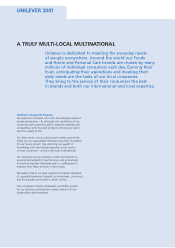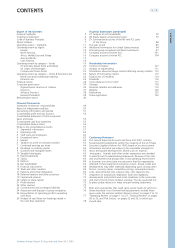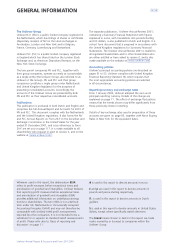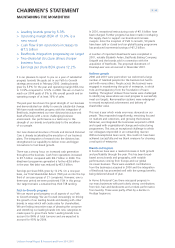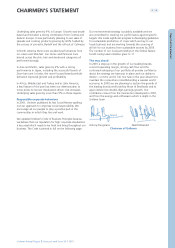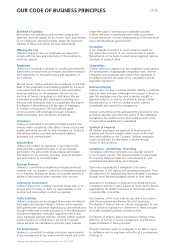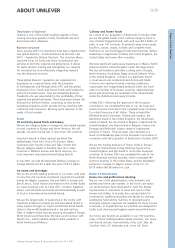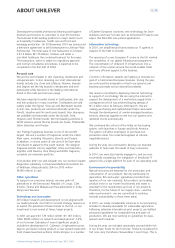Unilever 2001 Annual Report Download - page 13
Download and view the complete annual report
Please find page 13 of the 2001 Unilever annual report below. You can navigate through the pages in the report by either clicking on the pages listed below, or by using the keyword search tool below to find specific information within the annual report.
Unilever Annual Report & Accounts and Form 20-F 2001
ABOUT UNILEVER >10
Seasonality
Certain of our businesses, such as ice creams and prestige
fragrances, are subject to significant seasonal fluctuations in
sales. However, Unilever operates globally in many different
markets and product categories. No individual element of
seasonality is likely to be material to the results of the
Group as a whole.
People
year end in thousands 2001 2000 1999 1998 1997
Europe 71 80 74 80 82
North America 22 39 22 23 23
Africa, Middle East
and Turkey 49 48 50 59 60
Asia and Pacific 85 84 71 72 74
Latin America 38 44 29 31 30
Total 265 295 246 265 269
We are committed to building an enterprise culture: one
that acts as a springboard for individual and business success.
To help build this culture, in 2001, we ran a series of
challenging international events for both rising and
established managers. At these workshops, people worked
on their collective behaviours against stretching business
targets. Subsequently, local events were used to build
this culture.
We reshaped our business, moving to a divisional structure
and integrating the research and development functions
into the divisions. In line with our strategy, these changes
will allow us to direct our efforts more effectively behind
our leading brands. The programme of disposals announced
in 2000 as part of our brand focus, and the planned
synergy savings from the Bestfoods integration, have both
progressed well. These initiatives led to a reduction of some
30 000 staff over the year. We remain committed to dealing
openly and fairly with all those affected.
Our leadership development focuses on building the
skills required to achieve our business goals. In 2001,
we extended the Leaders into Action pilot programme to
a wider group of managers. The programme, which is part-
residential and part-online, includes personal, business and
community elements.
We also successfully launched ‘open job posting’. By
communicating management vacancies company-wide, this
system ensures that selection is fair and transparent. It was
rolled out globally early in 2002.
In 2001, we extended the Reward for Growth programme
and as a result over 6 000 managers worldwide qualify for
executive share options and a new global variable pay
scheme linked to growth. It is planned to extend the
variable pay scheme to a further 15 000 employees.
Related party transactions
Other than those disclosed in these accounts, there were
no related party transactions that were material to the
Group or to the related parties concerned that require
to be reported in 2001 or the preceding two years.
Transactions with related parties are conducted in
accordance with the transfer pricing policies described
on page 53 and consist primarily of sales to joint ventures.
Information concerning guarantees given by the Group is
stated in note 23 on page 75 and under ’Mutual guarantee
of borrowings’ on page 109.
Intellectual property
We have a large portfolio of patents and trademarks,
and we conduct some of our operations under our patents
or under licences which are based on patents or trademarks
owned or controlled by others. We are not dependent on
any one patent or group of patents. We use our best
efforts to protect our brands and technology.
Description of our properties
We have interests in properties in most of the countries
where there are Unilever operations, however, none
is material in the context of the Group as a whole.
The properties are used predominantly to house production
and distribution activities and as offices. There is a mixture
of leased and owned property throughout the Group.
There are no environmental issues affecting the properties
which would have a material impact upon the Group.
The directors take the view that any difference between
the market value of properties held by the Group and the
amount at which they are included in the balance sheet
is not significant. See the schedule of principal group
companies and fixed investments on page 97 and details
of tangible fixed assets in note 10 on page 65.
Legal and arbitration proceedings
We are not involved in any legal or arbitration proceedings
and do not have any obligations under environmental
legislation which we expect to lead to a loss material in
the context of the Group results. None of our directors or
officers are involved in any such material legal proceedings
against us.
Government regulation
Unilever businesses are governed, in particular, by national
laws designed to ensure that their products may be safely
used for their intended purpose and that their labelling and
advertising complies in all respects with relevant regulations.
The introduction of new products and ingredients and
processes is, specifically, subject to rigorous controls.
Unilever businesses are further regulated by data protection
and anti-trust legislation. Important regulatory bodies
include the European Commission and the US Food and
Drug Administration.


